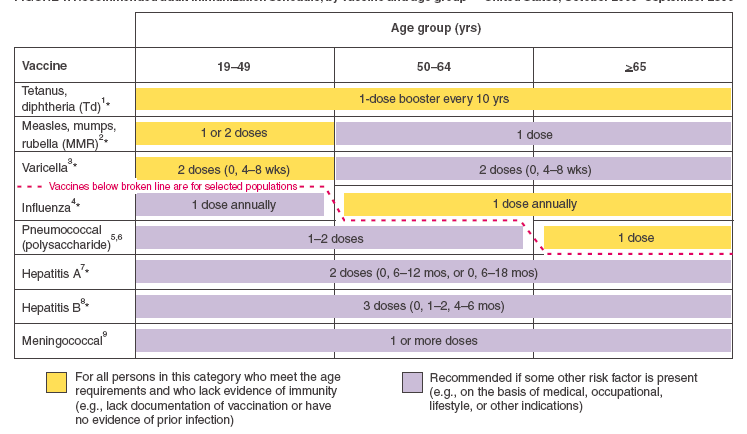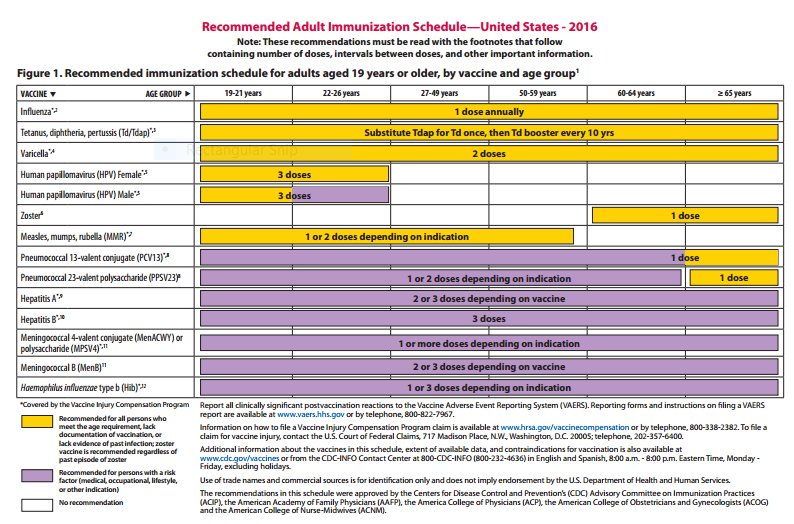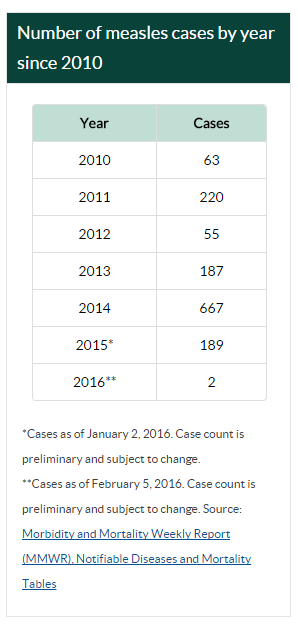February 26, 2016
 While doing research for an upcoming blog on the changing representation of “anti-vaxxers” in the media, I revisited some of last year’s media coverage of the recent measles outbreak at Disneyland. In the wake of that outbreak, the media turned on vaccine-hesitant parents with an unprecedented wave of vicious stories, frequently pitting more the more fearful parents against their neighbors. These articles blamed the then-current outbreak on a rising tide of vaccine exemptions and vaccine hesitancy in today’s parents, frequently referred to as the “anti-vaccine movement.” While rereading some of the more extreme pieces, I got curious about how all the finger pointing and dire predictions stacked up against the facts and did some digging.
While doing research for an upcoming blog on the changing representation of “anti-vaxxers” in the media, I revisited some of last year’s media coverage of the recent measles outbreak at Disneyland. In the wake of that outbreak, the media turned on vaccine-hesitant parents with an unprecedented wave of vicious stories, frequently pitting more the more fearful parents against their neighbors. These articles blamed the then-current outbreak on a rising tide of vaccine exemptions and vaccine hesitancy in today’s parents, frequently referred to as the “anti-vaccine movement.” While rereading some of the more extreme pieces, I got curious about how all the finger pointing and dire predictions stacked up against the facts and did some digging.
Turns out, they don’t stack up at all.
First off, the “patient zero” for the outbreak was never identified, though the strain of measles was identified and was consistent with measles circulating in other countries, including the Philippines. This implies that patient zero was likely to be an adult who had traveled from the Philippines. The fact that this person was never identified and had to have been present at Disneyland or another local theme park for a series of some five days means that it is likely patient zero did not evidence obvious symptoms of measles. A person with a high fever and obvious rash would have been noticeable, even in such a crowded place as Disneyland. This argues for the idea that patient zero had been previously vaccinated against measles as it is unlikely a non-vaccinated person would have such a mild measles infection. It is generally believed that vaccinated people tend to get milder, even subclinical cases of infection that may be contagious.
According to the CDC, there were a total of 111 cases of measles associated with this particular outbreak, and a total confirmed case number for 2015 of 189. Of the 159 cases reported by April 2, including all the Disneyland cases, a majority occurred in adults 20 years of age or older (89 cases or 56%), and only 29 cases (26%) were in deliberately non-vaccinated people. The CDC gives no age distribution, but at least one report of a deliberately non-vaccinated adult was made, so they were not all in school-aged children. In fact, we are not given any information as to the age distribution within the deliberately non-vaccinated group, making it impossible to determine for ourselves whether or not the numbers actually support any increased risk due to a growing number of non-vaccinating parents.
This outbreak represents a “worst-case scenario” in many ways, as wealthy families in Orange County, California (who can afford to go to Disneyland) are frequently cited as one of the largest “pockets” of vaccine resistance and the tourist attraction nature of Disneyland assured the maximum possible population exposure. And what was the eventual outcome of this worst-case scenario? No one died, and fewer than 29 deliberately non-vaccinated children got sick.
(What might be described as the very worst-case scenario occurred in 2014, when a group of largely non-vaccinated young Amish adults traveled to the Philippines to help with recovery from a devastating typhoon. The Philippines also happened to be experiencing a raging measles epidemic at the time. The Amish, by the way, traditionally do not vaccinate in high numbers due to their cultural and religious beliefs, thus they cannot be considered part of any “anti-vaccine movement,” exploding or otherwise. When the Amish relief workers came back to their also largely unvaccinated community, four young men were infected with measles. Their illness was originally misdiagnosed as dengue fever, which is not contagious, so no one thought to quarantine them, despite the fact that they presented with “textbook” cases of measles and had recently travel to a country in the midst of an measles epidemic. Even with these highly extraordinary circumstances, there were still only 667 cases all year, with no deaths and no other serious long-term effects reported in the media.)
Contrast the 2015 numbers with the comments of Dr. Anne Schuchat, Director of the CDC’s National Center for Immunization and Respiratory Diseases, who was quoted by Fox News in 2013 as saying that, of the 189 reported cases of measles to date that year (note that 2013 ended with 187 confirmed cases – this will become important later), 82% were in deliberately non-vaccinated people. Wait . . . you mean that the percentage of measles cases in deliberately non-vaccinated people was much lower in 2015 than it was in 2013, just two years before?
But weren’t we told (repeatedly, ad nauseum) that this “huge increase” in the incidence of measles in 2015 was due to the “anti-vaccine movement” which has gained so much momentum of late? How can this be?
An important clue lies in another, virtually ignored, statistic contained in both the 2013 and 2016 reports: In 2013 the number of people with “unknown” vaccination status was 4; in 2015, it was 60. That’s an increase of approximately 1,400% in two years. How is it possible that an increase that large in the number of people who don’t know their vaccination status could occur in just two short years? And how can there be so many people with “unknown” vaccination status when there is such a hard-and-fast number (29) for the deliberately non-vaccinated?
The following two charts can help us understand how this can be. The first chart is from the CDC adult recommended vaccine schedule for 2006; it says that MMR is “Recommended for all persons who meet the age requirements and who lack evidence of immunity (e.g. lack documentation of vaccination or have no evidence of prior infection)” (emphasis mine). In other words, two criteria must be fulfilled for the MMR to be recommended to an adult. The MMR was only recommended for adults who were in the age range who also had not been vaccinated or had not had measles.

Contrast that with the second chart, from 2016’s recommended adult schedule, which says that measles vaccine is “Recommended for those who meet the age requirements, lack documentation of vaccination, or lack evidence of past infection” (emphasis mine). The lack of the word and here is a subtle difference with a major impact. It’s an extremely sloppy recommendation, in fact, because it now means that only one of the three criteria mentioned must be fulfilled for the MMR to be recommended, meaning that the MMR is now recommended for all adults who “meet the age requirements,” as well as people who lack evidence of vaccination or infection (who presumably don’t meet the age requirements).
As WebMD puts it: “The CDC advises most adults born in 1957 or afterward get an MMR vaccine, whether they had one as a child or not” (emphases mine). The word most here is due to the fact that quite a few of those adults had measles as children, and will most likely be immune for life, though the wording on the new chart makes it appear that they do recommend the vaccine to these individuals anyway.

Why the change? Well, the CDC knows full well that vaccine-induced immunity eventually wears off. It’s not clear how long it would take for that to happen for any particular individual or how wide a range there is in the timeframe, and it seems that immunity wanes faster after boosters than for initial vaccination. In addition, the vaccine does not create “immunity” in everyone who receives it. There is a small percentage of people who never derive any sort of immunity from the vaccine (generally considered to be approximately 3%). The existence of these people in whom the vaccine fails to provoke any immunity, in combination with adults whose immunity has waned, means a significant percentage of the adult population is currently susceptible to measles, perhaps 10% or higher.
This explains why a majority of the Disneyland cases were in adults and why there are so many people with “unknown” vaccination status. In previous years, the vast majority of those 60 “unknowns” would count as “vaccinated” because, let’s face it, they were. The only reason why they’re considered “unknown” now is because they can’t remember if their doctor ever talked them into a booster – at a pre-college or pre-military service physical perhaps? If they didn’t (which is likely because the vast majority of adults have not had MMR boosters, believing themselves to be immune for life), then they no longer count as “up to date on immunizations.” If those 60 people were counted among the “previously vaccinated,” the total number of vaccinated individuals who got measles in 2015 before April 2 would come to 88 – or 55% – a majority of the total of 159. “Unknown” vaccine status turns out to be a very neat little trick to disguise the fact that the Disneyland outbreak was driven not by deliberately non-vaccinated children, as reported by every major news outlet, but rather by previously vaccinated adults.
While we’re digging around for facts, let’s look at one of the stranger aspects of measles case reporting, shall we?
The CDC tells us that there were a total of 189 cases of measles in the entire country for the year, and 159 of them were reported before April 2. I was watching the numbers as they were being reported from week to week, and at one point the number dropped significantly with no explanation as to why (I believe the reported high was 167 cases at the time). The likelihood seems to be that they were not “confirmed” cases of measles, meaning that they presented like measles and probably initially tested positive for measles and were, therefore, counted in the CDC total, but were eventually removed from the total.
I suspect the reason for this was because the particular measles strain detected in their blood was the vaccine strain. When that happens, no matter how much it looks like a duck, walks like a duck, and quacks like a duck, as in this example of a child in Baltimore,
The patient arrived Wednesday night at the MedStar Good Samaritan Hospital Emergency Department with a high fever, rash, runny nose, cough and watery eyes – all typical symptoms of measles.
The patient was seen subsequently, on the same night, at the Johns Hopkins Hospital Emergency Department, where they had labwork done that tested positive for the measles virus.”
it is apparently not a duck; the verdict is a “normal reaction” to the measles vaccine. As reported in the same article quoted above, “A small percentage of people who receive the vaccine develop fever, rash and measles-like symptoms as a reaction to the vaccine.”
Bizarrely, this “normal reaction” to the vaccine – that looks and acts a hell of a lot like “measles” – is often used as justification to promote further measles vaccination: As a Baltimore health official said in a follow-up to the above article, wherein it was reported that the little girl did have a “vaccine reaction” and not “measles”: “Let’s use this opportunity as a wake-up call to the importance of vaccinations.” For some reason that I can’t fathom, measles is considered extremely dangerous if it doesn’t come from the vaccine, but perfectly acceptable – nay, even something to be sought after – if it does.
This “normal reaction” to the measles vaccine (or vaccine shedding to the immunocompromised) may also explain why the CDC lists two measles fatalities in each of 2009 and 2010, but according to Fox News, Dr. Schuchat, who really ought to know, claimed in 2014 that there were no measles deaths reported in the U.S since 2003. How can we explain this discrepancy?
According to Snopes, the CDC justifies it by saying that the deaths were from “unconfirmed” cases of measles.
Really? Is that credible? Four reported deaths from measles went “unconfirmed” as late as 2010, when in 2015 it was confirmed that a woman had died of an undetected measles infection? Is it really plausible that four people may have died from reported measles infections and no one bothered to confirm it? Because if they had bothered to confirm, based on the apparent ability to confirm measles infection in a dead woman that health authorities didn’t even know had measles, surely they could have done so. I would be willing to make a substantial bet that the CDC would have been eager to confirm those deaths under ordinary circumstances.
Can we all agree that if those deaths were in people who got measles from non-vaccinated children that we would have heard about it – LOUDLY? What could be more effective for scaring or shaming people into vaccinating their children than deaths from measles? If these weren’t confirmed cases of measles, why weren’t they confirmed, and why do they continue to be listed as deaths from measles? The only likely scenario I can think of is that the hospitals involved did indeed confirm measles infection (just like the case of the little girl in Baltimore), but it was discovered on further testing that the strain of measles that caused each of the four deaths was the vaccine strain, automatically turning those “measles deaths” into “normal reactions” to the vaccine. It’s the only way that four measles deaths could possibly happen without any CDC acknowledgment.
So how does 2015’s horrifically dangerous outbreak of measles stack up historically? According to the CDC, since measles was declared “eliminated” in 2000, there have been two years with significantly higher numbers of cases, 2011 (220 cases) and 2014 (667 cases), and in fact, even back in 2001, the year after measles was declared “eliminated” in the United States, there were 116 cases. You can see on this chart that there have only been two cases reported so far this year. At that rate, 2016 could well turn out to have the lowest incidence of measles on record.

In conclusion, it’s pretty clear that, despite a tremendously vitriolic and hysterical media campaign aimed at vaccine-hesitant parents, which was then used as a justification for the introduction of bills intended to eliminate vaccine exemptions to state legislatures all around the country, there is no indication whatsoever that the Disneyland outbreak of measles was part of a current or oncoming public health crisis, much less one that could be attributed to vaccine-hesitant parents.
Nor was the Disneyland outbreak a harbinger of an imminent return to the pre-measles-vaccine era. It was merely a fairly predictable and ordinary outbreak, begun by a traveler from a foreign country, in a population with a growing percentage of susceptible adults. Therefore, neither the hysteria and finger-pointing generated by the CDC and vaccine manufacturers’ PR machine, nor the huge backlog of proposed punitive vaccine legislation around the country, including California’s recent removal of any kind of personal belief exemption, can be justified by any sober perusal of the facts.
~ Professor
For more by Professor, click here.

















Thank you so much for this article and breakdown of the numbers. It’s been written in easy to understand language, with links to support the information. These are the types of articles I thoroughly enjoy sharing with my friends and family that still don’t get it. Your article will make it very easy for them to understand what I have such a hard time articulating myself. Thank you, Prof.
You’re welcome, Diane! Any time. 😉
Thank you for doing this breakdown! I have to tell you, I do not believe for one second that the number of completely “unconfirmed” is that high. I would love to have a definition of “unconfirmed” by the CDC. When my daughter came back from India and was taken to the ER for stomach problems – she was tested for salmonella – which came back positive. The health department, even though they were informed she got sick IN India, called every single day for 2 months to try to discuss the issue with her – as part of their investigation (in case she got it in the U.S. which we 100% know was not the case). if the CDC wanted to know vaccine status, they would know. And because most states have vaccine registries for children, and children get these vaccines from their doctors, I believe that the “unknown” really were most likely adults or they were actually vaccinated and the CDC knew it! A shill with the CDC (a vaccine champion) told me that the unconfirmed are included in the number of unvaccinated. Convenient, no?
I appreciate your efforts, and wanted to point out what appears to be an error regarding the total number of cases in 2015.
In the third paragraph: “a total confirmed case number for 2015 of 189”
In the paragraph below the 2nd graphic: “the total number of vaccinated individuals who got measles in 2015 would come to 88 – or 55%, a majority of the total of 159”
Then in the following paragraph, perhaps this is where the 159 came from; “The CDC tells us that there were a total of 189 cases of measles in the entire country for the year, and 159 of them were reported before April 2.”
I think the number in the middle quote is incorrect (and hence the calculation of 55% is also incorrect). But maybe I’m misunderstanding something?
In any case I thank you for your efforts to put this together.
Oh, thank you! It was a bit difficult trying to keep all the different case numbers straight. I’ll fix it.
Update: fixed it. The breakdown numbers were out of the pre-April 2 totals, so the percentage is still correct and definitely applies to the Disneyland outbreak. Thanks for checking up on me! It would have been a lot less confusing if the first quarter total and the full-year total didn’t both end in 9!
Thank you for taking the time to do this research! The CDC and Big Pharma bank on the fact that most people won’t take the time to do it! The research reveals the truth – manufactured “epidemics” to sell product and cull the population.
You’re welcome Kassie! There are so many times that I have looked deeper into health-related topics only to find that the truth doesn’t look anything like what we’re being told (it’s a lot like history books…) that I just jump in and wander down the rabbit hole. Sometimes I find that “our side” has misrepresented things as well, though most of the time I think that is from misunderstanding a difficult topic, not deliberately trying to misrepresent it.
Excellent, again.
Thank you.
You’re welcome. And, thank YOU. 🙂
Thank you, Professor, for reading between the lines and putting the measles “crisis” in perspective for us!
You’re welcome. 🙂